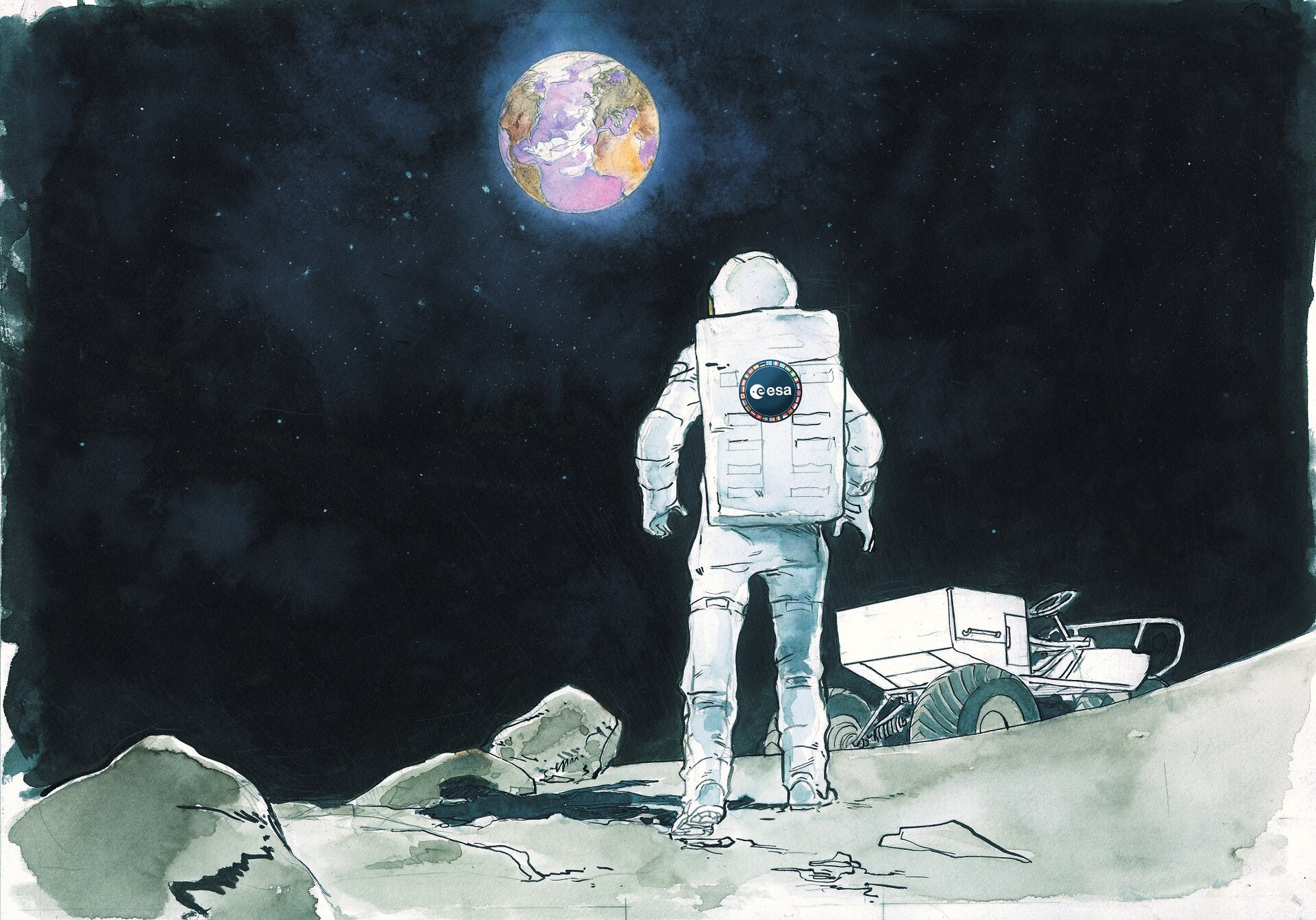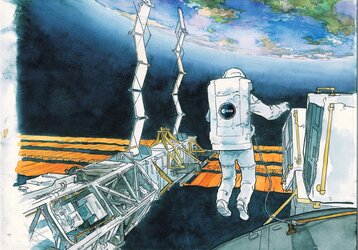Accept all cookies Accept only essential cookies See our Cookie Notice

About ESA
The European Space Agency (ESA) is Europe’s gateway to space. Its mission is to shape the development of Europe’s space capability and ensure that investment in space continues to deliver benefits to the citizens of Europe and the world.
Highlights
ESA - United space in Europe
This is ESA ESA facts Member States & Cooperating States Funding Director General Top management For Member State Delegations European vision European Space Policy ESA & EU Space Councils Responsibility & Sustainability Annual Report Calendar of meetings Corporate newsEstablishments & sites
ESA Headquarters ESA ESTEC ESA ESOC ESA ESRIN ESA EAC ESA ESAC Europe's Spaceport ESA ESEC ESA ECSAT Brussels Office Washington OfficeWorking with ESA
Business with ESA ESA Commercialisation Gateway Law at ESA Careers Cyber resilience at ESA IT at ESA Newsroom Partnerships Merchandising Licence Education Open Space Innovation Platform Integrity and Reporting Administrative Tribunal Health and SafetyMore about ESA
History ESA Historical Archives Exhibitions Publications Art & Culture ESA Merchandise Kids Diversity ESA Brand Centre ESA ChampionsSpace in Member States
Find out more about space activities in our 23 Member States, and understand how ESA works together with their national agencies, institutions and organisations.
Science & Exploration
Exploring our Solar System and unlocking the secrets of the Universe
Go to topicAstronauts
Missions
Juice Euclid Webb Solar Orbiter BepiColombo Gaia ExoMars Cheops Exoplanet missions More missionsActivities
International Space Station Orion service module Gateway Concordia Caves & Pangaea BenefitsLatest
Space Safety
Protecting life and infrastructure on Earth and in orbit
Go to topicAsteroids
Asteroids and Planetary Defence Asteroid danger explained Flyeye telescope: asteroid detection Hera mission: asteroid deflection Near-Earth Object Coordination CentreSpace junk
About space debris Space debris by the numbers Space Environment Report In space refuelling, refurbishing and removingSafety from space
Clean Space ecodesign Zero Debris Technologies Space for Earth Supporting Sustainable DevelopmentApplications
Using space to benefit citizens and meet future challenges on Earth
Go to topicObserving the Earth
Observing the Earth Future EO Copernicus Meteorology Space for our climate Satellite missionsCommercialisation
ESA Commercialisation Gateway Open Space Innovation Platform Business Incubation ESA Space SolutionsLatest
Enabling & Support
Making space accessible and developing the technologies for the future
Go to topicBuilding missions
Space Engineering and Technology Test centre Laboratories Concurrent Design Facility Preparing for the future Shaping the Future Discovery and Preparation Advanced Concepts TeamSpace transportation
Space Transportation Ariane Vega Space Rider Future space transportation Boost! Europe's Spaceport Launches from Europe's Spaceport from 2012Latest

Terrae Novae destinations: Moon
Thank you for liking
You have already liked this page, you can only like it once!
At the beginning of this decade, space exploration is at an unprecedented crossroads.
When embarking on an ambitious and challenging journey, having a good roadmap is always recommended.
Terrae Novae is ESA’s exploration programme. The Terrae Novae 2030+ strategy roadmap has been created as a flexible instrument with options to tune the decisions that must be taken for European exploration in view of scientific and technological breakthroughs and considering the evolving political and programmatic landscape, as well as the level of ambition and affordability at the time the decisions are taken.
Terrae Novae is not only literally about exploring new worlds, but by describing the limitless opportunities for discovery, economic growth and inspiration it also expresses our ambitions for Europe’s future innovators, scientists and explorers.
We hope that everyone can use this roadmap to make our three-part vision a reality: to continue a strong presence working in low-Earth orbit, to send the first European astronauts to explore the Moon throughout the 2030s, and to prepare Europe’s role in the first historic human voyage to Mars.
While always delivering measurable benefits for society today and tomorrow, the top objectives are threefold: to create new opportunities in Earth orbit for a sustained European presence in the post-International Space Station era, to enable the first European to explore the Moon’s surface by 2030 as a step towards sustainable lunar exploration in the 2030s, and to prepare the horizon goal of Europe being part of the first human mission to Mars.
The Terrae Novae 2030+ strategy roadmap has ambitious goals for each of the three exploration destinations low Earth orbit, Moon and Mars. The high-level ambitious goal for the Moon is to have the first European astronaut land on the Moon before 2030 by providing autonomous Moon landing capabilities for European-led missions within an international cooperation context, developing scientific and infrastructure assets, and preparing for sustained lunar exploration in the 2030s, possibly also seizing new cooperation opportunities in human landing and surface mobility capabilities.
For more on ESA’s human and robotic exploration strategy see: https://www.esa.int/terraenovae
-
CREDIT
ESA–Olivier Pâques -
LICENCE
ESA Standard Licence

Terrae Novae destinations: Earth orbit spacewalk

Terrae Novae destinations: Earth orbit cupola

Terrae Novae destinations: Mars

Terrae Novae destinations: Earth















 Germany
Germany
 Austria
Austria
 Belgium
Belgium
 Denmark
Denmark
 Spain
Spain
 Estonia
Estonia
 Finland
Finland
 France
France
 Greece
Greece
 Hungary
Hungary
 Ireland
Ireland
 Italy
Italy
 Luxembourg
Luxembourg
 Norway
Norway
 The Netherlands
The Netherlands
 Poland
Poland
 Portugal
Portugal
 Czechia
Czechia
 Romania
Romania
 United Kingdom
United Kingdom
 Slovenia
Slovenia
 Sweden
Sweden
 Switzerland
Switzerland

























